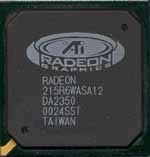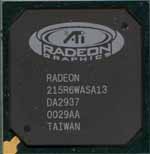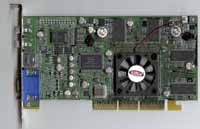The Card
A quick glance at both the Radeon DDR and the Radeon LE will reveal some striking similarities. The board PCBs are essentially identical, with the Radeon LE containing the silk-screen imprints of a number of components missing on the Radeon LE. Nearly all of the components not found on the Radeon LE but present on the Radeon DDR relate to the Radeon DDR's VIVO capabilities which the Radeon LE lacks. This includes the ATI Rage Theater chip to the right of the heatsink and fan and the two video outputs and single video input found on the Radeon DDR's base. And while the memory chips may look physically different, the Radeon LE uses the same DDR SDRAM that the Radeon DDR uses except for the fact that the LE version uses slower rated 6ns (166MHz) memory while the Radeon DDR uses faster 5.5ns (181MHz) chips. Also the same is the memory bus width, which remains at 128-bits, keeping it a step above the Radeon SDR and Radeon VE solutions.
In order to ensure that the Radeon LE does not infringe on the Radeon DDR's performance margin, the card comes clocked quite a bit lower than the Radeon DDR; 35MHz slower to be exact. The Radeon LE ships with a 148MHz clock speed for both the memory and the core. It is for this reason that the Radeon LE is able to get away with using lower rated 6ns (166MHz) DDR SDRAM chips.
Missing on the Radeon LE is the active cooling method that the Radeon DDR uses. Instead, the Radeon LE uses a larger heatsink only cooling setup; a setup which should not hinder performance at all, considering the fan on the Radeon DDR is almost unquestionably not needed and only added for aesthetic value.
 |
 |
|
Radeon
LE Chip
|
Radeon
DDR Chip
|
Since the Radeon LE uses the exact same core as the Radeon DDR, it does not loose any of the Radeon DDR's powerful features except for one, but more on that in a minute. The Radeon LE, unlike the Radeon VE, still features ATI's T&L engine, the Charisma, running at the full core speed of 148MHz. This means that features like vertex skinning and keyframe interpolation are supported by the Radeon LE. The rendering pipeline count remains at two, each capable of processing 3 texels per second. Crunching the numbers gives us a theoretical fill rate of 888 megatexels per second and 296 megapixels per second at the 148MHz clock speed.
|
Video
Card Specification Comparison
|
||||||||
|
ATI
Radeon DDR
|
ATI
Radeon DDR OEM
|
ATI
Radeon LE
|
ATI
Radeon SDR
|
ATI
Radeon VE
|
||||
| Core |
Rage
6C
|
Mobile
Rage 6C
|
||||||
|
Clock Speed |
183MHz
|
166MHz
|
148MHz
|
166MHz
|
183MHz
|
|||
| Number of Chips |
1
|
1
|
1
|
1
|
1
|
|||
| Rendering Pipelines |
2
|
2
|
2
|
2
|
1
|
|||
| Texels/Clock |
3
|
3
|
3
|
3
|
3
|
|||
| Texels/Second |
1100
Million
|
996
Million
|
888
Million
|
996
Million
|
549
Million
|
|||
| Memory Bus |
128-bit
DDR
|
128-bit
SDR/DDR
|
128-bit
DDR
|
128-bit
SDR
|
64-bit
DDR
|
|||
| Memory Clock |
183MHz
DDR (366 MHz)
|
166
MHz DDR (333MHz)
|
148MHz
DDR
|
166MHz
SDR
|
183MHz
DDR (366MHz)
|
|||
| Memory Bandwidth |
5.8 GB/s
|
5.3 GB/s
|
4.7
GB/s
|
2.6
GB/s
|
2.9
GB/s
|
|||
| Manufacturing Process |
0.18-micron
|
|||||||
As a final note, don't worry about the Radeon LE loosing ATI's mainstay iDCT technology that greatly improves DVD playback: the Radeon LE features the same iDCT functions as the Radeon DDR. Also present is the same high quality 350MHz RAMDAC that ATI has become famous for.
So, besides the lower clock speed, which will obviously make a noticeable performance difference, what is the other feature left out of the Radeon LE that was hinted at before? Well, it is the lack of a portion of HyperZ technology. Although ATI's own website proclaims that "HyperZ technology ... [is] not in the Radeon LE" our tests have shown that not only does the Radeon LE come with fully functional HyperZ features, the Radeon LE arrives out of the box with HyperZ actually enabled in OpenGL but not in D3D. This must have seem like a perfect solution for ATI: cripple the card by lowering the clock speed and simultaneously slow the card down in D3D by disabling HyperZ features; but with all the similarities the card shares with the full fledged Radeon DDR, there must be some way around those pesky thorns in the Radeon LE's side.












0 Comments
View All Comments